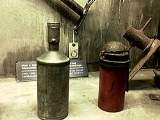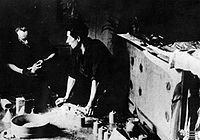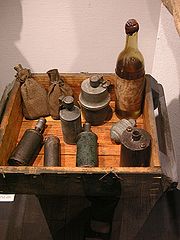
Sidolówka
Encyclopedia
Sidolówka was an unofficial, yet common, name of the R wz. 42 hand grenade
, produced by the Polish resistance organization Armia Krajowa
in occupied Poland during World War II
.
The name of the grenade came from Sidol, a metal-cleaning agent from Henkel
sold in Poland at the time. The first grenades used the Sidol bottles as the coating. Later on the coating was purposely modelled after the bottle in order to allow for easier hiding of the weapon.
 Sidolówka was first produced in Warsaw
Sidolówka was first produced in Warsaw
in 1942, by the professors of the Warsaw University of Technology
under the leadership of Jan Czochralski
. It was partially based on an earlier design of the Filipinka
grenade, also of underground construction, which in turn was based on a pre-war Polish ET-38 anti-tank grenade. The primer and the detonator were designed by two engineers of the pre-war Polish munition works in Warsaw
, pyrotechnician Władysław Pankowski and engineer Józef Michałowski.
It was a fragmentation grenade
with a P-42 friction primer and a 4.5 second delay time. Until the end of the World War II
, an estimate of 350,000 R-42 were produced in Polish underground factories. A large number of such grenades were used in the Warsaw Uprising
and other battles of the Operation Tempest
.

Hand grenade
A hand grenade is any small bomb that can be thrown by hand. Hand grenades are classified into three categories, explosive grenades, chemical and gas grenades. Explosive grenades are the most commonly used in modern warfare, and are designed to detonate after impact or after a set amount of time...
, produced by the Polish resistance organization Armia Krajowa
Armia Krajowa
The Armia Krajowa , or Home Army, was the dominant Polish resistance movement in World War II German-occupied Poland. It was formed in February 1942 from the Związek Walki Zbrojnej . Over the next two years, it absorbed most other Polish underground forces...
in occupied Poland during World War II
World War II
World War II, or the Second World War , was a global conflict lasting from 1939 to 1945, involving most of the world's nations—including all of the great powers—eventually forming two opposing military alliances: the Allies and the Axis...
.
The name of the grenade came from Sidol, a metal-cleaning agent from Henkel
Henkel
Henkel AG & Co. KGaA is an multinational company headquartered in Düsseldorf, Germany.The company operates in three business areas: Home Care , Personal Care ,...
sold in Poland at the time. The first grenades used the Sidol bottles as the coating. Later on the coating was purposely modelled after the bottle in order to allow for easier hiding of the weapon.

Warsaw
Warsaw is the capital and largest city of Poland. It is located on the Vistula River, roughly from the Baltic Sea and from the Carpathian Mountains. Its population in 2010 was estimated at 1,716,855 residents with a greater metropolitan area of 2,631,902 residents, making Warsaw the 10th most...
in 1942, by the professors of the Warsaw University of Technology
Warsaw University of Technology
The Warsaw University of Technology is one of the leading institutes of technology in Poland, and one of the largest in Central Europe. It employs 2,453 teaching faculty, with 357 professors . The student body numbers 36,156 , mostly full-time. There are 17 faculties covering almost all fields of...
under the leadership of Jan Czochralski
Jan Czochralski
Jan Czochralski was a Polish chemist who invented the Czochralski process, which is used to grow single crystals and is used in the production of semiconductor wafers....
. It was partially based on an earlier design of the Filipinka
Filipinka
Filipinka was an unofficial, yet common name for the ET wz. 40 hand grenade produced for the Armia Krajowa during World War II in occupied Poland....
grenade, also of underground construction, which in turn was based on a pre-war Polish ET-38 anti-tank grenade. The primer and the detonator were designed by two engineers of the pre-war Polish munition works in Warsaw
Warsaw
Warsaw is the capital and largest city of Poland. It is located on the Vistula River, roughly from the Baltic Sea and from the Carpathian Mountains. Its population in 2010 was estimated at 1,716,855 residents with a greater metropolitan area of 2,631,902 residents, making Warsaw the 10th most...
, pyrotechnician Władysław Pankowski and engineer Józef Michałowski.
It was a fragmentation grenade
Fragmentation grenade
A fragmentation grenade is an anti-personnel weapon that is designed to disperse shrapnel upon exploding. The body is made of hard plastic or steel. Flechettes, notched wire, ball bearings or the case itself provide the fragments...
with a P-42 friction primer and a 4.5 second delay time. Until the end of the World War II
World War II
World War II, or the Second World War , was a global conflict lasting from 1939 to 1945, involving most of the world's nations—including all of the great powers—eventually forming two opposing military alliances: the Allies and the Axis...
, an estimate of 350,000 R-42 were produced in Polish underground factories. A large number of such grenades were used in the Warsaw Uprising
Warsaw Uprising
The Warsaw Uprising was a major World War II operation by the Polish resistance Home Army , to liberate Warsaw from Nazi Germany. The rebellion was timed to coincide with the Soviet Union's Red Army approaching the eastern suburbs of the city and the retreat of German forces...
and other battles of the Operation Tempest
Operation Tempest
Operation Tempest was a series of uprisings conducted during World War II by the Polish Home Army , the dominant force in the Polish resistance....
.


